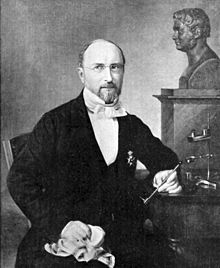Carl Gustav Mosander
Carl Gustav Mosander (born September 10, 1797 in Kalmar , Sweden , † October 15, 1858 in Ängsholm , Sweden) was a Swedish chemist and surgeon.
Life
After an apprenticeship as a pharmacist, Mosander studied medicine from 1819. He later worked as a professor of surgery at the Karolinska Institute in Stockholm . Jöns Jacob Berzelius got him excited about chemistry at an early age and became his mentor. In 1836 he succeeded him as a full professor of chemistry and pharmacy .
In 1839 a newly discovered lanthanum mineral was named Mosandrite in honor of Mosander .
Services
Mosander studied rare earth chemistry for over 20 years and discovered several chemical elements .
In 1826 he noticed an additional oxide in the cerite . In the years 1839 to 1843 he separated cerite into cerium (IV) -, the speculative didymoxide and lanthanum oxide . On this basis he isolated compounds of lanthanum for the first time (1839) and postulated an element didymium in 1840 , which later turned out to be a mixture of praseodymium and neodymium .
In 1843 he discovered yttrium , erbium and terbium from that of Johan Gadolin 1794 described yttria .
literature
- Levi Tansjö: Episodes from the History of the Rare Earth Elements . Ed .: CH Evans. Springer Science & Business Media, December 6, 2012, Carl Gustaf Mosander and His Research on Rare Earths, p. 38-55 ( online ).
Web links
| personal data | |
|---|---|
| SURNAME | Mosander, Carl Gustav |
| BRIEF DESCRIPTION | Swedish chemist and surgeon |
| DATE OF BIRTH | September 10, 1797 |
| PLACE OF BIRTH | Kalmar , Sweden |
| DATE OF DEATH | October 15, 1858 |
| Place of death | Ängsholm , Sweden |
